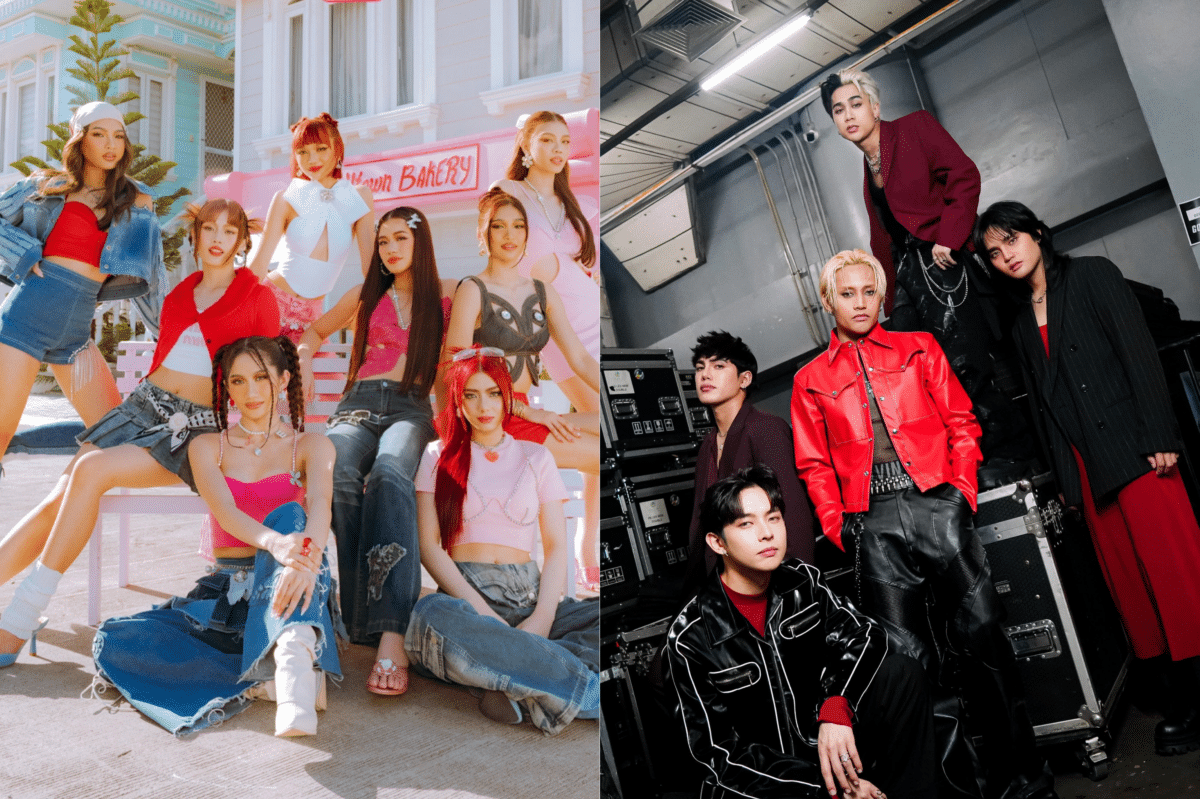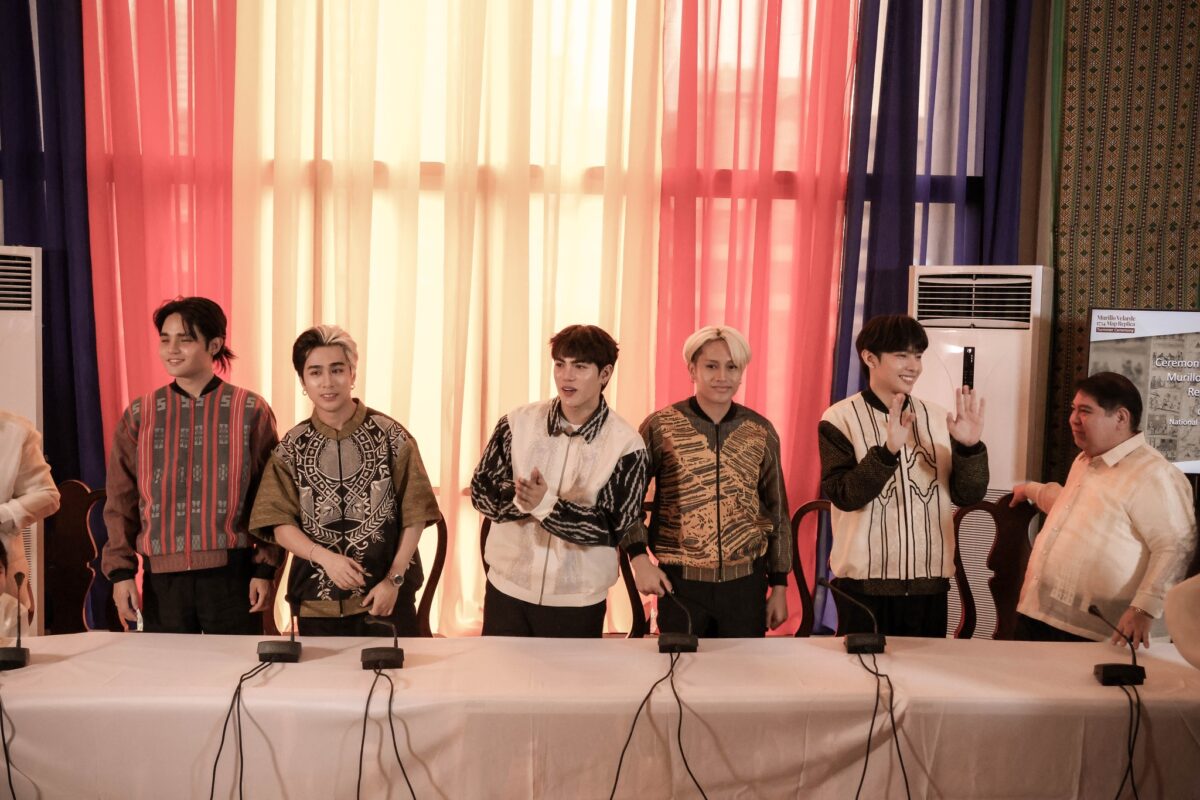
BINI and SB19 are the biggest P-pop groups today. Image: Courtesy of ABS-CBN Corporation, 1Z Entertainment
SB19 and BINI are the biggest groups in P-pop. Both carved their respective paths and paved the way for their peers to establish themselves. Their rise to fame and mainstream recognition, however, came at a tough price, with both groups having their own struggles to get to where they are.
SB19, consisting of Pablo, Josh, Stell, Ken, and Justin, debuted in October 2018 with “Tilaluha.” But a dance practice video of their 2019 track “Go Up” propelled them to recognition. At the moment, they’re maintaining their momentum with the help of their self-managed label 1Z Entertainment. After all, it took time before they reached a settlement with their former agency, ShowBT Philippines. Dubbed the P-pop Kings, they have been on a constant rise since then.
BINI’s case was different. Before being known as the “Nation’s Girl Group,” their debut was momentarily halted by the COVID-19 pandemic and ABS-CBN’s shutdown in 2020. They eventually debuted a year later. But it took several tries — and determination to defeat the underlying misogyny in music — before achieving mainstream fame. What was their ticket to fame? “Pantropiko,” their first EP “Talaarawan,” and several “Bini core” edits on social media.
“To be fair, it took SB19 and BINI years to build a robust and well-coordinated support system capable of rallying behind them,” music publicist Ian Urrutia told INQUIRER.net in an interview.

SB19 during the 1734 Murillo Velarde map turnover ceremony in Manila. Image: Courtesy of the National Library of the Philippines
Debuting a P-pop group in the saturated music scene is a gamble in itself. But for many of them, it is only the beginning. While entertainment companies are tasked with building a group’s momentum, Urrutia pointed out that many tend to “overly focus on mimicking the strategies of K-Pop and J-Pop” without paying attention to the “unique dynamics” of OPM.
“Achieving domestic success requires a deep understanding of local tastes and preferences,” Urrutia added. “It would be far more effective to collaborate with seasoned Filipino hitmakers who have a proven track record of success. They are adept at translating the P-Pop sound into something modern and deeply rooted in Pinoy culture.”
Being “deeply rooted in Pinoy culture” is among the factors that played a role in SB19 and BINI’s success, according to Ateneo de Manila University professor Andrea Trinidad. As someone who taught P-pop as an elective, she noted that SB19’s “real and raw” talent is what resonated with the public, touching on the Filipinos’ high standard for singers.
Aside from music, the charm of BINI lies in their image. They are female friends who “enjoy themselves and work hard,” Trinidad said. “BINI presented an image of girls na barkadahan… their ‘walang pake sa idol image’ attitude contributes to the growing attention surrounding their releases, where hooked audiences.”
How P-pop can set itself apart?
A sub-genre of OPM, P-pop during the 2020s has entered a renaissance with the incorporation of idol groups. MNL48, a sister group of AKB48 was the trailblazer. SB19 came next, setting an all-Filipino standard for the next generation to follow. More groups debuted since then, but the majority have yet to establish themselves in the public.
To attract fans, it’s about realizing the value of “starting local,” Urrutia said, noting that it can be seen in the case of Alamat.
“They benefited immensely from working with local veterans like Thyro [Alfaro, which has helped them unlock their full potential. Sometimes, the key to success lies right at home,” he said. A singer-songwriter-producer, Alfaro is known for producing chart-topping songs such as Alamat’s “Maharani,” James Reid’s “Randomantic,” and Sarah Geronimo’s “Kilometro,” to name a few.
Starting local can also be done by using our national language in interviews or using familiar catchphrases that an everyday Filipino knows. For Filipino-American journalist Lai Frances, through BINI, she discovered the joy of “understanding” their interviews and other related content, which eventually, drew her into P-pop.
“While my cousin and I [were watching BINI’s content], we realized that we understood what they’re saying. What’s amazing is that when P-pop blows up, this will be something that we know. It’s something we can continue to champion with whoever we talk to or whoever comes across it,” she said.
Another defining characteristic of P-pop, according to Frances, is personality. ”
In other Asian countries, K-pop and J-pop idols often maintain an image of being proper and innocent. When an idol does something displeasing in public — such as rejecting requests for “aegyo (or making yourself cute),” cursing, or being “too stubborn,” they’re often subject to scrutiny.
P-pop idols are different. They are free to let loose on their TikTok pages through funny dances (as seen in BINI Sheena and Maloi’s kampana dance), being upfront in dealing with bashers, and willing to join along with their fans’ sense of humor, to name a few.
“What I find particularly compelling about P-Pop is its evolution: slowly but surely, it’s shedding the overly polished, synthetic sheen often associated with mainstream pop. Instead, it’s embracing a more layered, sonically adventurous approach that not only has the potential to compete on the global stage but also retains a distinct, homegrown authenticity,” Urrutia said of P-pop’s departure from its more curated counterparts.
BINI members (from upper left) Colet, Maloi, Gwen, Jhoanna, Stacey; (from lower left) Aiah, Sheena, and Mikha. Image: X/@bini_ph
Trinidad said that fans knowing the “OA and nonchalant members of SB19, BINI, Alamat, and other groups are an example of the industry’s personality.
“Being unapologetically Filipino in humor and fan interactions is what sets them apart from their onstage personas, Stell and Jhoanna are big examples of this,” she said. “This avoids the overly manufactured and ultra polished image that we’re far from.”
For 1ST ONE’s leader Ace, being “genuine” matters not only among the boy group but also with their colleagues.
“What matters is how we are genuine and how we come across [to the audience]. We don’t want to reach the phase of simply creating. We should not forget the heart in what we do,” he told INQUIRER.net.
How can P-pop truly rise?
Often used as a hashtag on social media or chant during shows, “P-pop Rise” is the industry’s battlecry. This means that the success of one P-pop group is the success of everyone else. This is also one of the underlying meanings in the lyrics of G22’s song “Boomerang” where they sang, “This is not a competition but a revolution.”
While SB19 and BINI contribute to the growth of the industry, Urrutia, Trinidad, and members of 1ST ONE and 6ENSE believe that mainstream media has a role to play in helping the industry grow.
Providing a “proper avenue” can boost P-pop, according to Trinidad, Ace, and 6ENSE’s Wiji. This includes organizing P-pop-themed performances, allowing idols to appear on TV and other web appearances, or launching a music show, among other suggestions.
“What’s lacking in P-pop are the mediums to be seen. South Korea has weekly music shows, chart rankings, and other outlets,” Ace told INQUIRER.net. “While we’re in a growing industry, it’s hard to sustain P-pop groups if they’re not seen or heard. When we debuted during the pandemic, we struggled the most in securing TV appearances to show what kind of singers and dancers we are.”
Wiji said that having proper avenues is a helpful way of motivating groups to move forward. “I hope there will be a show for P-pop and indie artists,” he said. “It helps in promoting aspiring and rising artists to be known to the general public.”
Aside from the proper avenue, Ace stressed that mainstream media needs to “support all groups.” This was echoed by Urrutia, who pointed out that being “more inclusive and open” in reporting about P-pop can help an act be known.
“If media outlets were more open to covering stories that are just as interesting and compelling as the usual suspects, I believe it would enrich the industry and create more variety. A broader, more inclusive approach would ultimately benefit everyone, and in return, ignite more dynamic conversations about P-Pop,” he said.
Trinidad also stressed the importance of doing “proper research” when it comes to telling stories about the industry. “Other press members claim that they just found out about a certain group during an event itself. They should be more open in knowing more about them, which in turn, can help in creating a proper space and opportunity for them.”
Fans, budget matter
Aside from mainstream media, Trinidad hopes for entertainment companies to “listen to fans” and have a proper budget when it comes to marketing P-pop groups properly.
“Fans don’t hesitate to dedicate their resources, talents, and skills to help their idol rise. At the same time, it doesn’t hurt to have a proper budget for P-pop idol groups when it comes to the clothes they wear, social media content, and more,” she said.
At the same time, investing in music producers who can experiment with the “Pinoy qualities of P-pop” helps in creating a more adventurous space in the industry.
“I love to see more young producers willing to push P-Pop into a sonically adventurous space, exploring new and unexpected sounds,” Urrutia said. “I love to hear more idol groups experimenting with unconventional production styles and genres, and would be game to carve out their own identity instead of conforming to the typical molds.”
P-pop groups gather for a group photo in the 2022 P-pop Convention or PPOPCON. Image: PPOPCON/Facebook
The music publicist also challenged P-pop groups to sing in “regional languages” aside from English and Filipino. “I love them to tell stories that draw from their rich cultural and social backgrounds, and make it universally appealing, songwriting-wise,” he said.
While fans matter in P-pop’s rise, KAIA’s Sophia reiterated the importance of creating a positive community among fandoms. “Fans are a reflection of us and our character,” she explained to INQUIRER.net.
“At the end of the day, your idols have one goal — to make P-pop bigger,” she continued. “We hope we can celebrate each other because the success of one group is a success for the whole P-pop community.”
KAIA’s leader Angela echoed Sophia’s thoughts, saying that P-pop groups help each other in helping the public be aware of the industry. “We are very good friends with all of them. We support each other,” she said. “When a group releases something, we’re very happy. We know their struggles. They know ours.”
All these aside, P-pop has a long way to go. But artists and the people who work with them are hopeful that the industry will be fully embraced by the public.
“I envision P-Pop as a multi-dimensional movement. P-pop has the potential to evolve in exciting, unforeseen directions, and I hope to see it continue to broaden its scope. Of course, none of this will be fully realized without substantial government support to help propel the movement to a global stage. The right backing could make all the difference,” Urrutia said.

